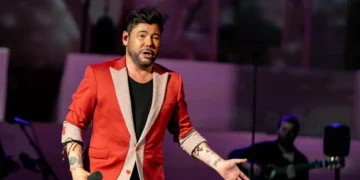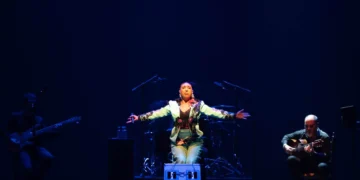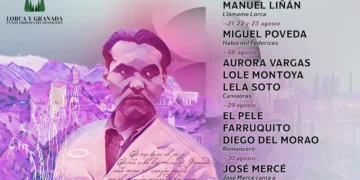|
XVI BIENAL DE FLAMENCO DE SEVILLA |
|
Text: Estela Zatania SPECIAL COVERAGE: BIENAL DE FLAMENCO DE SEVILLA 2010 It makes you feel small. All this hoopla that now surrounds an art-form born of such humble beginnings. You read more about elections, sponsorship and political infighting than about the art itself. But it’s the Bienal folks, and last night, in Seville’s historic bullring called the Maestranza, the mega festival was spectacularly, unforgettably and formally opened. The seven thousand souls that Jerez couldn’t draw just a few days ago to its Fiesta de la Bulería, despite featuring the town’s biggest box-office draws, handily filled that many seats in the spacious plaza, with everything sold out days earlier and plenty of people left at the door to haggle with the scalpers. It’s only logical that an event of this magnitude wasn’t going to take place in an intimate setting. And once again I had the sensation of “lots of cash on stage”, however this time it hadn’t been spent on costly props, foreign choreographers or designer lighting. What was on display were three years of hard work, the commitment of more than 80 highly-qualified artists and the sheer love of flamenco, humanity and seemingly limitless talent of mister Miguel Poveda. A show for the history books, no doubt about it. We’ll never turn our backs on Camarón, who together with Paco de Lucía crafted a new flamenco world. But last night somehow, a page was turned and we entered into the age of Poveda. At a quarter past ten, with the presence of numerous artists, bullfighters, journalists, Andalusia’s jet-set and plenty of “normal” people too, “Historias de Viva Voz” got underway. According to the star’s webpage, “an elaborate work conceived to remember and honor the many voices of flamenco, an intense, personal journey through the history of cante, a tribute to flamenco […]”. Ambitious goals of the type one learns to take with a grain of salt; artists tend to gush a bit, and then do whatever they well please. But Miguel Poveda is special. He’s one of the few to maintain his perspective, and his sincere humility and honesty, and he would not let himself get carried away by the abundance of resources. What was offered could be described as a series of well-crafted suites. A brief prelude danced by the amazing Rafael Esteve with Nani Paños and Antonio Ruz, morphs us into the voice of Poveda which cuts the silence with livianas a capella…discreet guitar sounds begin to move the air, toná liviana…emotions begin to well up…nanas with Alfredo Lagos, Jesús Guerrero and Chicuelo on guitar, marianas with a privileged chorus of voices that includes Miguel Lavi, David el Galli, Paco el Trini, Mara Rey, Juan José Amador, Inmaculada Rivero, Sandra Carrasco and Carmen Grilo, each one with a solo bit up front, and Luís Cantarote and Carlos Grilo on palmas. An ingenious transition to a subtle drone allows Poveda’s flamenco magic to keep flowing. Alegrías danced in the most traditional style by Laura Rozalén is intended to recall the bailaoras of the old café cantantes, but being overweight is no guarantee of good dancing (if you get what I mean), and it was one of the few weak moments. The caña sung by Miguel with a splendid arrangement respectful of the form, including vocal harmony in the lament, leads to the shifting of chairs to assemble the numerous cast as a café cantante audience who listen to Poveda’s polo de Tobalo and a sort of apolá suite. With barely a break, somehow we’re into peteneras. It was at this precise moment I had the thought “if flamenco has to be on a grand scale, this is how it should be, without causing undue stress to fans of classic cante nor losing sight of the aesthetic”. The Orquesta Joven de Andalucía, under the direction of Michael Thomas, gets to work accompanying the free-form petenera of Pastora and the Medinas. Miguel’s standard repertoire also came in handy, the malagueña of Peñaranda, jabera, a lightning-fast verdial, a laidback fandango de Lucena…it’s another suite, one of malagueña and abandolao, with taranto for good measure. When Poveda suddenly shouts “Morao, viva Jerez!”, it has the effect of making the popular guitarist materialize on-stage guitar in hand, and a bulerías happening ensues with the whole cast, with sounds of Lebrija and Utrera included. The Catalonian is elegant in his movements; since the days of Bambino, few artists have known how to move about the stage with such swagger while doling out large tasty portions of flamenco. Exquisite taste and artistic sensitivity. After an hour and a half, just when you think it can’t get any better, the sound of bongos sends us back to the 1960’s with the surprising sound of rumba Catalana in all its past glory, and Poveda appears wearing a multicolored refractory jacket that manages to symbolize the era in a good-natured tribute, as he does Bambino’s hit song “Déjame en paz en paz en paz”. The women singers then take turns with bulerías, and Miguel’s lyrical song to orchestra might have been left out without causing any damage. Cante flamenco and “copla” have always impressed me as stange bedfellows, despite the custom of putting them side by side. The dancers return to prelude a virtual musical tour of the province of Huelva, and a fandango facing-off between Poveda and Sandra Carrasco triggers enthusiastic applause. The most ingenious number of the evening, and which could easily have been the end of the lengthy presentation, was a medley of song fragments in which the dancers quickly dressed up Poveda in a matter of seconds to recall Chacón, Valderrama, Caracol, Marchena, Miguel de Molina, Porrinas and even Carlos Gardel, with the singer delivering the corresponding voice and repertoire of each. I think at this point thousands of people had the same thought as me: this man from northern Spain is an artist’s artist, a musician’s musician and a flamenco’s flamenco. Another suite was devoted to tangos of Titi de Triana, with the suggestive dancing so typical of the patios of Triana we relate to these cantes. It takes a deep knowledge of flamenco to accurately conjure up so many different flavors. An assortment of soleá de Triana, siguiriyas and cabales with Morao and just for good measure, “Alfileres de Colores” and the alegrías cantiñas Poveda always does so well. Esperanza Fernández dressed in electric red, “La Leyenda del Tiempo” couldn’t be left out, soleá with orchestra accompaniment…. We wind up gratefully exhausted, and three hours of flamenco orgy went by without becoming oppressive. An authentic compendium of flamenco, folklore and popular Spanish song of the twentieth century, an important show that cannot be repeated, with intelligent and effective staging, and we don’t want to forget special mention for Rafael Estévez who is credited as artistic and musical director. Miguel Poveda in his most glorious moment, at the peak of a sort of success that didn’t used to be within reach of flamencos, without owing anything to anyone as the cantaor had sung in one of his verses. And that’s just how it is, Miguel. Congratulations.
|
Descubre más desde Revista DeFlamenco.com
Suscríbete y recibe las últimas entradas en tu correo electrónico.


























